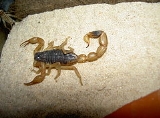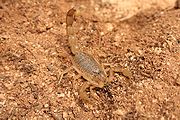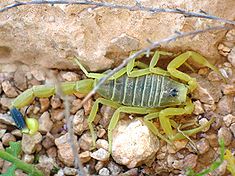
Buthidae
Encyclopedia
Buthidae is the largest family
of scorpion
s, containing about 80 genera
and over 800 species
as of mid-2008. Its members are known as, for example, thick-tailed scorpions and bark scorpions. There are a few very large genera (like Ananteris
, Centruroides
, Compsobuthus
or Tityus
), but also a high number of species-poor or monotypic
ones. New taxa are being described at a rate of several to several dozen new species per year. They occur in the warmer parts of every major landmass on Earth, except on New Zealand
. Together with the Microcharmidae, the Buthidae make up the superfamily
Buthoidea. The family was established by Carl Ludwig Koch
in 1837.
Some Buthidae are of medical importance, and the sting of a few can kill humans. If you are unaware of the exact species
and not experienced in handling scorpions, it is better to keep a respectful distance. In dead specimens, the spine beneath the sting, characteristic for this family, can be observed.
s), Apistobuthus, and Centruroides
; and can reach a dozen cm (approximately 5 inches). Most of them have between two and five pairs of eyes. Some resemble Vaejovidae
. Chaerilidae and Chactidae have one pair of eyes at most, and the former show a yellowish spot between and to the rear of these.
Their vernacular name refers to the thick tails found in many Buthidae, especially in the Old World
. The pedipalp
s on the other hand tend to be weak, slender and tweezer-like. Members of Buthidae are generally rather cryptically
colored, quite uniformly ochre to brown, but some are black or (like Centruroides and Uroplectes) more vividly colored. More conspicuous patterns and shapes occur e.g. in Isometrus or Lychas.
-rich genera
– fattail scorpion
s (Androctonus), Centruroides
, Hottentotta
, Leiurus
, Parabuthus and Tityus
– are notorious for their strong venom. Human fatalities have been recorded from fewer than two dozen species; identification of e.g. a particular Tityus is likely problematic and detailed data on the venom exists only for a small fraction of the Buthidae (see BmKAEP
from the venom of Mesobuthus martensii
, for an example).


Family (biology)
In biological classification, family is* a taxonomic rank. Other well-known ranks are life, domain, kingdom, phylum, class, order, genus, and species, with family fitting between order and genus. As for the other well-known ranks, there is the option of an immediately lower rank, indicated by the...
of scorpion
Scorpion
Scorpions are predatory arthropod animals of the order Scorpiones within the class Arachnida. They have eight legs and are easily recognized by the pair of grasping claws and the narrow, segmented tail, often carried in a characteristic forward curve over the back, ending with a venomous stinger...
s, containing about 80 genera
Genera
Genera is a commercial operating system and development environment for Lisp machines developed by Symbolics. It is essentially a fork of an earlier operating system originating on the MIT AI Lab's Lisp machines which Symbolics had used in common with LMI and Texas Instruments...
and over 800 species
Species
In biology, a species is one of the basic units of biological classification and a taxonomic rank. A species is often defined as a group of organisms capable of interbreeding and producing fertile offspring. While in many cases this definition is adequate, more precise or differing measures are...
as of mid-2008. Its members are known as, for example, thick-tailed scorpions and bark scorpions. There are a few very large genera (like Ananteris
Ananteris
Ananteris is a little-known genus of rare scorpions. It contains 64 species found in South America.Species include:*Ananteris faguasi Bojero-Trujillo, 2009*Ananteris nairae Lourenço, 2004*Ananteris pydanieli Lourenço, 1982...
, Centruroides
Centruroides
Centruroides is a genus of scorpions belonging to the family Buthidae. Several North American species are known by the common vernacular name bark scorpion. Numerous species are extensively found throughout the southern United States, Central America, the Antilles and northern South America...
, Compsobuthus
Compsobuthus
Compsobuthus is a genus of Buthid scorpions.-Species:Compsobuthus contains many species, including:*C. abyssinicus *C. acutecarinatus *C. afghanus Kovarik & Ahmed, 2007*C. andresi Lourenço, 2004...
or Tityus
Tityus (genus)
Tityus is a large genus of thick-tailed scorpions , the namesake of its subfamily Tityinae. , Tityus contains more than 200 described species distributed throughout the Caribbean and South America and in Central America as far north as Costa Rica...
), but also a high number of species-poor or monotypic
Monotypic
In biology, a monotypic taxon is a taxonomic group with only one biological type. The term's usage differs slightly between botany and zoology. The term monotypic has a separate use in conservation biology, monotypic habitat, regarding species habitat conversion eliminating biodiversity and...
ones. New taxa are being described at a rate of several to several dozen new species per year. They occur in the warmer parts of every major landmass on Earth, except on New Zealand
New Zealand
New Zealand is an island country in the south-western Pacific Ocean comprising two main landmasses and numerous smaller islands. The country is situated some east of Australia across the Tasman Sea, and roughly south of the Pacific island nations of New Caledonia, Fiji, and Tonga...
. Together with the Microcharmidae, the Buthidae make up the superfamily
Taxonomic rank
In biological classification, rank is the level in a taxonomic hierarchy. Examples of taxonomic ranks are species, genus, family, and class. Each rank subsumes under it a number of less general categories...
Buthoidea. The family was established by Carl Ludwig Koch
Carl Ludwig Koch
Carl Ludwig Koch was a German entomologist and arachnologist. He was responsible for classifying a great number of spiders, including the Brazilian whiteknee tarantula and Common house spider. He was born in Kusel, Germany and died in Nuremberg, Germany.Carl Ludwig Koch was an inspector of water...
in 1837.
Some Buthidae are of medical importance, and the sting of a few can kill humans. If you are unaware of the exact species
Species
In biology, a species is one of the basic units of biological classification and a taxonomic rank. A species is often defined as a group of organisms capable of interbreeding and producing fertile offspring. While in many cases this definition is adequate, more precise or differing measures are...
and not experienced in handling scorpions, it is better to keep a respectful distance. In dead specimens, the spine beneath the sting, characteristic for this family, can be observed.
Description
Few Buthidae scorpions are among the larger scorpions; on average the members of this family are mid-sized tending towards smallish. Microtityus and Microbuthus barely reach 2 cm (0.8 in). The largest members are found among Androctonus (fattail scorpionFattail scorpion
Fattail scorpion or fat-tailed scorpion is the common name given to scorpions of the genus Androctonus, which is one of the most dangerous groups of scorpions species in the world. They are found throughout the semi-arid and arid regions of the Middle-East and Africa. They are a moderate sized...
s), Apistobuthus, and Centruroides
Centruroides
Centruroides is a genus of scorpions belonging to the family Buthidae. Several North American species are known by the common vernacular name bark scorpion. Numerous species are extensively found throughout the southern United States, Central America, the Antilles and northern South America...
; and can reach a dozen cm (approximately 5 inches). Most of them have between two and five pairs of eyes. Some resemble Vaejovidae
Vaejovidae
Vaejovidae is a family of scorpions, comprising 17 genera, all found in Mexico and the southwestern United States:*Franckeus Soleglad & Fet, 2005*Gertschius Graham & Soleglad, 2007*Hoffmannius Soleglad & Fet, 2008...
. Chaerilidae and Chactidae have one pair of eyes at most, and the former show a yellowish spot between and to the rear of these.
Their vernacular name refers to the thick tails found in many Buthidae, especially in the Old World
Old World
The Old World consists of those parts of the world known to classical antiquity and the European Middle Ages. It is used in the context of, and contrast with, the "New World" ....
. The pedipalp
Pedipalp
Pedipalps , are the second pair of appendages of the prosoma in the subphylum Chelicerata. They are traditionally thought to be homologous with mandibles in Crustacea and insects, although more recent studies Pedipalps (commonly shortened to palps or palpi), are the second pair of appendages of the...
s on the other hand tend to be weak, slender and tweezer-like. Members of Buthidae are generally rather cryptically
Crypsis
In ecology, crypsis is the ability of an organism to avoid observation or detection by other organisms. It may be either a predation strategy or an antipredator adaptation, and methods include camouflage, nocturnality, subterranean lifestyle, transparency, and mimicry...
colored, quite uniformly ochre to brown, but some are black or (like Centruroides and Uroplectes) more vividly colored. More conspicuous patterns and shapes occur e.g. in Isometrus or Lychas.
Toxicity and relationship with humans
A handful of sometimes speciesSpecies
In biology, a species is one of the basic units of biological classification and a taxonomic rank. A species is often defined as a group of organisms capable of interbreeding and producing fertile offspring. While in many cases this definition is adequate, more precise or differing measures are...
-rich genera
Genera
Genera is a commercial operating system and development environment for Lisp machines developed by Symbolics. It is essentially a fork of an earlier operating system originating on the MIT AI Lab's Lisp machines which Symbolics had used in common with LMI and Texas Instruments...
– fattail scorpion
Fattail scorpion
Fattail scorpion or fat-tailed scorpion is the common name given to scorpions of the genus Androctonus, which is one of the most dangerous groups of scorpions species in the world. They are found throughout the semi-arid and arid regions of the Middle-East and Africa. They are a moderate sized...
s (Androctonus), Centruroides
Centruroides
Centruroides is a genus of scorpions belonging to the family Buthidae. Several North American species are known by the common vernacular name bark scorpion. Numerous species are extensively found throughout the southern United States, Central America, the Antilles and northern South America...
, Hottentotta
Hottentotta
Hottentotta is a genus of scorpion belonging to the family Buthidae. It is distributed widely across Africa , the Middle East, including the Arabian Peninsula and southeastern Turkey, Iraq, Iran, Afghanistan, Pakistan, India, and Nepal.-Taxonomy:The genus was introduced in 1908 by A. A. Birula,...
, Leiurus
Leiurus
Leiurus is a genus of scorpion belonging to the family Buthidae. The most common species, L. quinquestriatus, is also known under the vernacular name Deathstalker. It is distributed widely across North Africa and the Middle East, including the western and southern Arabian Peninsula and southeastern...
, Parabuthus and Tityus
Tityus (genus)
Tityus is a large genus of thick-tailed scorpions , the namesake of its subfamily Tityinae. , Tityus contains more than 200 described species distributed throughout the Caribbean and South America and in Central America as far north as Costa Rica...
– are notorious for their strong venom. Human fatalities have been recorded from fewer than two dozen species; identification of e.g. a particular Tityus is likely problematic and detailed data on the venom exists only for a small fraction of the Buthidae (see BmKAEP
BmKAEP
BmKAEP is a neurotoxin from the venom of the Manchurian scorpion . It is a β-toxin, which shift the activation voltage of sodium channels towards more negative potentials.- Etymology :...
from the venom of Mesobuthus martensii
Mesobuthus martensii
Mesobuthus martensii is a species of scorpion in the family Buthidae. Its common names include Chinese scorpion, Manchurian scorpion, Chinese armor-tail scorpion and Chinese golden scorpion. Despite its common name, this scorpion is not only found in Manchuria or China, but also in Mongolia, Korea...
, for an example).
List of genera and species


- Afghanobuthus Lourenco, 2005
- Afroisometrus Kovarik, 1997
- Akentrobuthus Lamoral, 1976
- Alayotityus Armas, 1973
- AnanterisAnanterisAnanteris is a little-known genus of rare scorpions. It contains 64 species found in South America.Species include:*Ananteris faguasi Bojero-Trujillo, 2009*Ananteris nairae Lourenço, 2004*Ananteris pydanieli Lourenço, 1982...
- Androctonus – fattail scorpions
- Anomalobuthus
- Apistobuthus
- Australobuthus
- Babycurus
- Baloorthochirus
- Birulatus
- ButhacusButhacusButhacus is a genus of scorpion belonging to the family Buthidae. It is distributed across northern and western Africa, Israel, Syria, the Arabian Peninsula, Iraq, Iran, Afghanistan, and Pakistan.- Taxonomy :...
- Butheoloides
- Butheolus
- Buthiscus
- Buthoscorpio (includes "Stenochirus" jinnahii and "S." rahmatii)
- Buthus
- CentruroidesCentruroidesCentruroides is a genus of scorpions belonging to the family Buthidae. Several North American species are known by the common vernacular name bark scorpion. Numerous species are extensively found throughout the southern United States, Central America, the Antilles and northern South America...
– typical bark scorpions - Charmus
- Cicileus
- Cicileiurus
- CompsobuthusCompsobuthusCompsobuthus is a genus of Buthid scorpions.-Species:Compsobuthus contains many species, including:*C. abyssinicus *C. acutecarinatus *C. afghanus Kovarik & Ahmed, 2007*C. andresi Lourenço, 2004...
- Congobuthus
- Darchenia
- Egyptobuthus
- Grosphus
- Hemibuthus
- Hemilychas
- Himalayotityobuthus
- Hoplocystis (a nomen dubiumNomen dubiumIn zoological nomenclature, a nomen dubium is a scientific name that is of unknown or doubtful application...
) - HottentottaHottentottaHottentotta is a genus of scorpion belonging to the family Buthidae. It is distributed widely across Africa , the Middle East, including the Arabian Peninsula and southeastern Turkey, Iraq, Iran, Afghanistan, Pakistan, India, and Nepal.-Taxonomy:The genus was introduced in 1908 by A. A. Birula,...
- Iranobuthus
- Isometrus
- Isometroides
- Karasbergia
- Kraepelinia
- Lanzatus
- LeiurusLeiurusLeiurus is a genus of scorpion belonging to the family Buthidae. The most common species, L. quinquestriatus, is also known under the vernacular name Deathstalker. It is distributed widely across North Africa and the Middle East, including the western and southern Arabian Peninsula and southeastern...
- Liobuthus
- Lissothus
- Lychas
- Lychasoides
- Mauritanobuthus
- Mesobuthus (paraphyletic?)
- Mesotityus
- Microananteris
- Microbuthus
- Microtityus
- Neobuthus
- Neogrosphus
- Odontobuthus
- Odonturus
- Orthochirus
- Orthochiroides
- Orthochirus (includes Paraorthochirus and Simonoides)
- Parabuthus
- Pectinibuthus
- Physoctonus
- Plesiobuthus
- Polisius
- Psammobuthus
- Pseudolissothus
- Pseudolychas
- Pseudouroplectes
- Razianus
- Rhopalurus
- Sabinebuthus
- Sassanidothus
- Somalibuthus
- Somalicharmus
- Thaicharmus
- Tityobuthus
- Tityopsis
- TityusTityus (genus)Tityus is a large genus of thick-tailed scorpions , the namesake of its subfamily Tityinae. , Tityus contains more than 200 described species distributed throughout the Caribbean and South America and in Central America as far north as Costa Rica...
- Troglorhopalurus
- Troglotityobuthus
- †UintascorpioUintascorpioUintascorpio is an extinct genus of scorpion in the family Buthidae and containing the single species Uintascorpio halandrasorum...
(EoceneEoceneThe Eocene Epoch, lasting from about 56 to 34 million years ago , is a major division of the geologic timescale and the second epoch of the Paleogene Period in the Cenozoic Era. The Eocene spans the time from the end of the Palaeocene Epoch to the beginning of the Oligocene Epoch. The start of the...
, Green River FormationGreen River FormationThe Green River Formation is an Eocene geologic formation that records the sedimentation in a group of intermountain lakes. The sediments are deposited in very fine layers, a dark layer during the growing season and a light-hue inorganic layer in winter. Each pair of layers is called a varve and...
) - Uroplectes
- Uroplectoides
- Vachoniolus
- Vachonus
- Zabius

